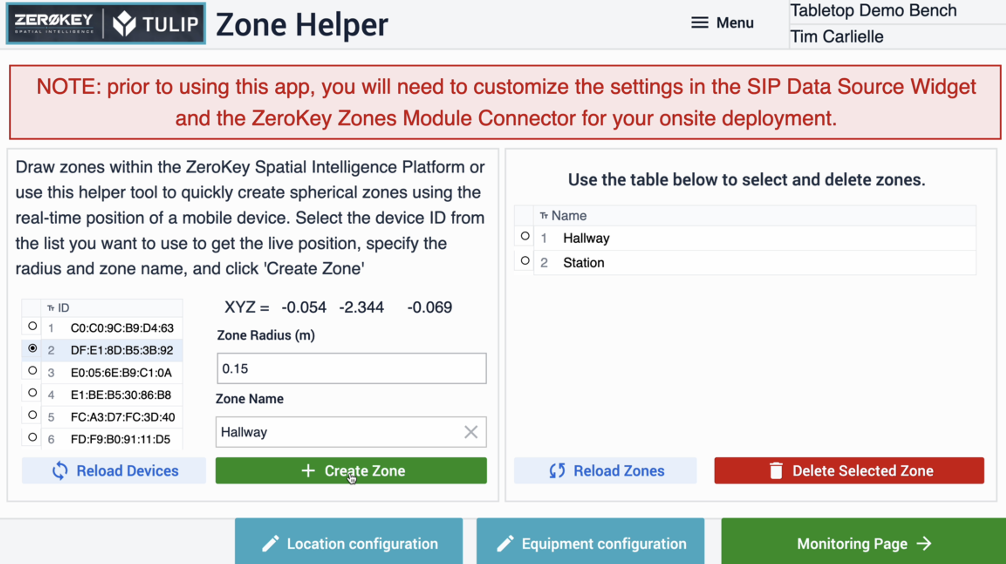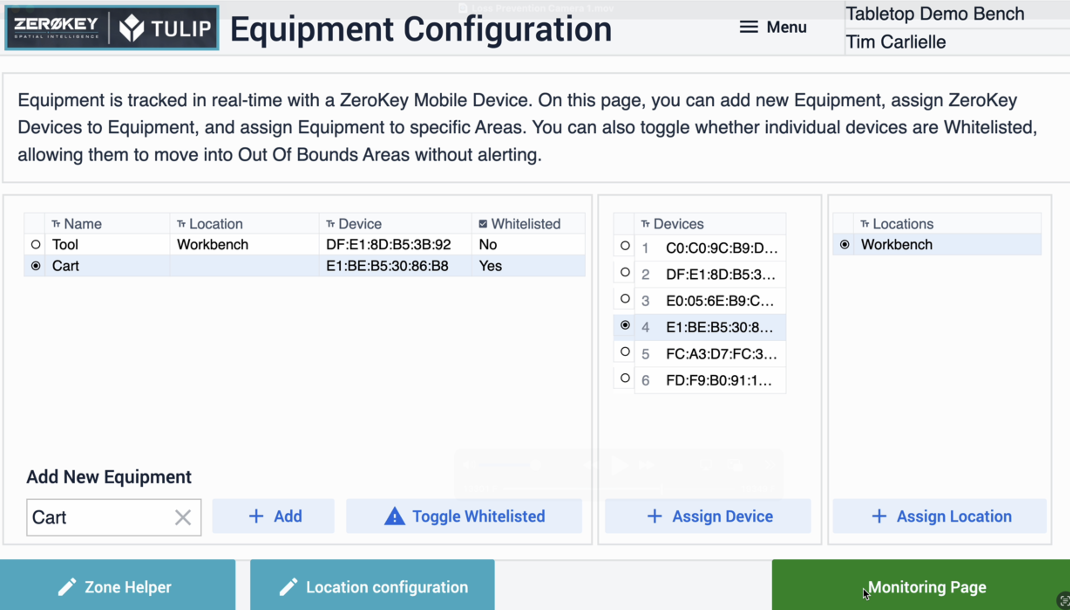Introduction
This article will describe how to connect a Quantum RTLS 2.0 deployment to the Loss Prevention Template App on the Tulip Library to:
-
Dynamically create 3D zones within your physical environment
-
Assign zones to Locations within Tulip’s Common Data Model
-
Assign ZeroKey Mobiles to Equipment and Assets within Tulip’s Common Data Model
-
Monitor the production environment and generate real time alerts for nonconformities (i.e., equipment leaving it’s assigned stations or entering an out of bounds area)
-
Whitelist Equipment to allow them to move freely without alerting
-
Designate specific Locations as Out Of Bounds
Easily apply this template application to your own use case by integrating ZeroKey Zones and Devices within a common data model. Use the predefined alert triggers to send notifications to key personnel, trigger IP cameras to take a photo, and more when nonconformities are detected.
Requirements
-
An existing Quantum RTLS 2.0 deployment with ZeroKey SIP 2.3.0 or higher
- To verify your SIP version in the dashboard, click the ZeroKey Logo in the top left corner
-
Connection of your ZeroKey Edge Compute Device to a network with unrestricted internet access
-
A Professional or enterprise subscription to Tulip Interfaces
-
(Optional but recommended) The ability to connect your Tulip client devices to the same local network as the ZeroKey Edge Compute Device
Obtain your Edge Compute Device’s (ECD’s) Cloud URL
In the dashboard, navigate to the System tab and go to the Information section. Here, you’ll see values under ECD Edge URL, ECD Cloud URL, ECD Serial Number, and Hardware Identifier.

You will need the ECD Cloud URL for the ZeroKey Connector Suite. You will need either the ECD Cloud URL or the ECD Edge URL for the Base Layout ZeroKey Custom Widget. The Edge URL may only be used if both the ZeroKey System and the Tulip client device are on the same LAN but will minimize event latency between the systems.
Configure the Connector Environment Settings
This app requires the use of the ZeroKey Connector Suite. If not already configured, follow the instructions in the support article to configure the Connector Environment Settings and test the connection.
To learn more about the ZeroKey Connector configuration visit this page.
Configure the Base Layout Custom Widget
This app uses the ZeroKey Custom Widgets to trigger logic based on real time data coming out of your ZeroKey system and will require you to configure the connection settings in the SIP Data Source Widget on the Base Layout of the app.
Select the ZeroKey Icon on the Base Layout of the app and input your ECD Cloud or Edge URL and credentials into their respective fields.

Create Zones
When the app is first opened, the Admin step will display a list of all the ZeroKey Mobile devices connected to the system. Select the MAC address corresponding to a device you want to use to create Zone locations. Once selected, the real time coordinates will be displayed on screen. Specify a radius for the zones (in meters) and the zone name. Position the device you selected in the center of your new zone and click Create Zone. A new spherical zone will then be created centered on the live position of the Mobile.
You may also create zones within the ZeroKey dashboard. Generally, workstations and out of bounds areas are best created this way as you can more precisely draw polygon zones around the exact boundaries of the location, however, using the app to create spherical zones is a quick and easy starting point for evaluation purposes. Regardless of whether the zones are created from the dashboard or from the Tulip Zone Helper step, they will show up on this step. If you create a zone from the dashboard while this step is open, you will need to click the Reload Zones button to refresh the table.

Using the Location Configuration Step
This step allows you to create new Locations, assign Zones to Locations, and toggle whether the Location is Out Of Bounds or not.
To link a ZeroKey Zone to a Location, select the entities you want to link from both tables and click Assign Zone to Area.
To toggle whether a Location is an Out Of Bounds area, selection the Location and click Toggle Out Of Bounds. Out Of Bounds areas will trigger alerts when any (non-whitelisted) Equipment enters the area.

Using the Equipment Configuration Step
This step allows you to add new Equipment, assign ZeroKey devices to specific Equipment, assign Locations to Equipment, and toggle whether Equipment is Whitelisted or not.
To assign a ZeroKey device to Equipment, select the entities you wish to link from their respective tables and click Assign Device.
Ditto Locations.
To toggle whether Equipment is Whitelisted, select the record you wish to toggle and click Toggle Whitelisted.

Using the Monitoring Step
When open to the Monitoring step, the app uses Zone Entry and Zone Triggers on the SIP Event Trigger Widget to automatically detect nonconformities and generate alerts as Equipment leaves it’s assigned location, or non-whitelisted equipment enters an out of bounds area.
The step will display the details of the for recent alerts, using local app variables to store the data that are subsequently overwritten the next time an alert is created. In a production environment, a Table could be used to store alert information for future recall. Other actions can be added to the Zone Entry and Zone exit triggers as needed to Email or SMS a manager, trigger a security camera, turn on an Andon light, etc.

Further Reading
If you want to know more about our partnership with ZeroKey visit our partner page.
To learn more about ZeroKey solutions you can check out these resources: